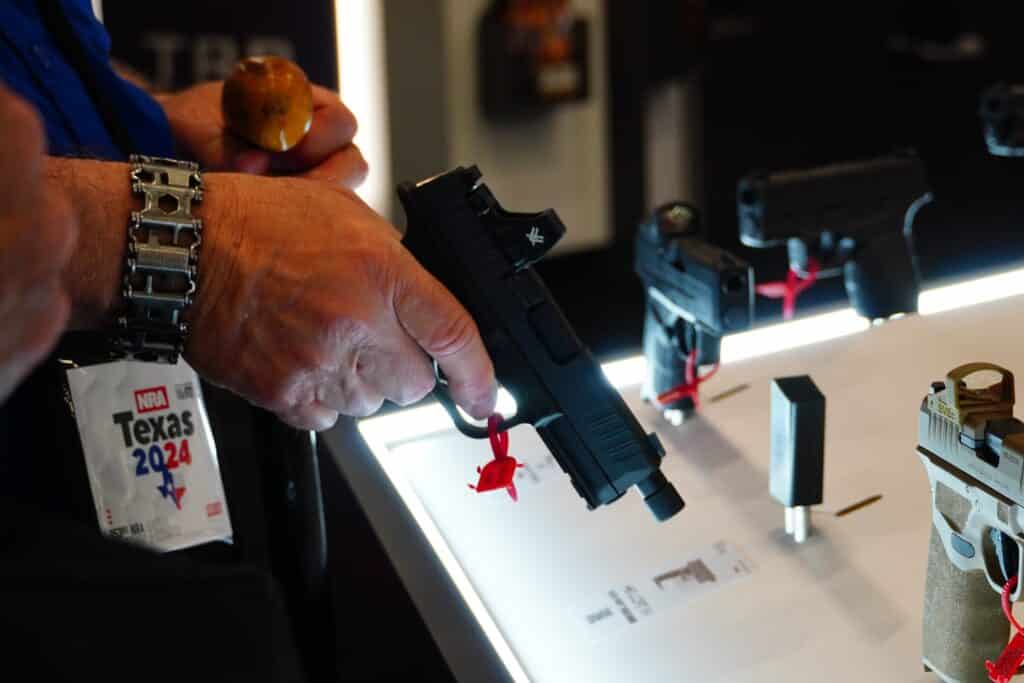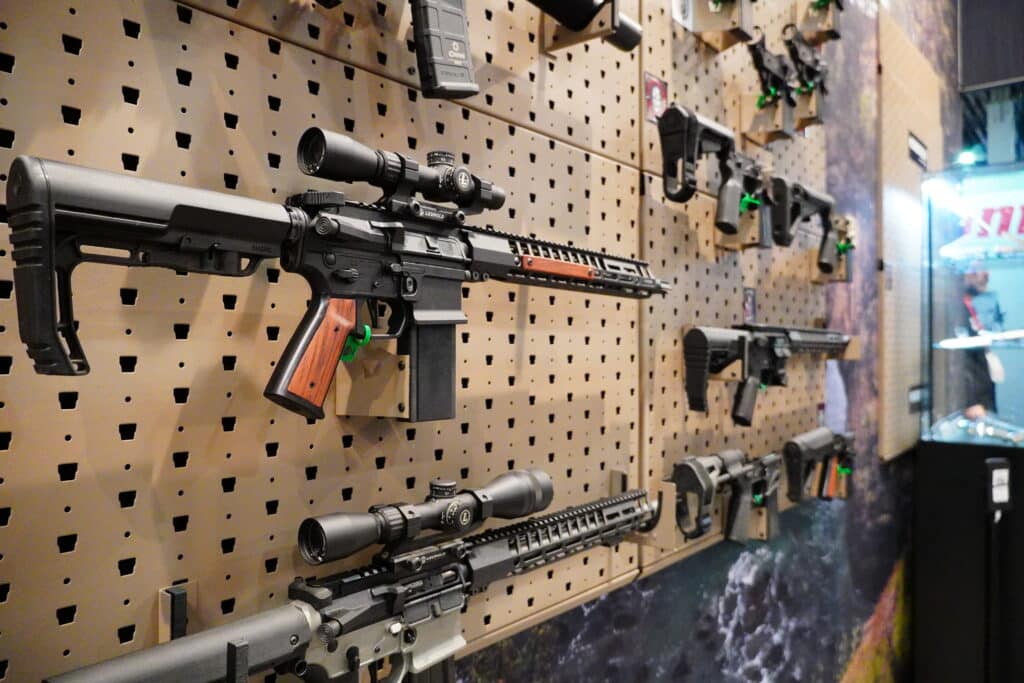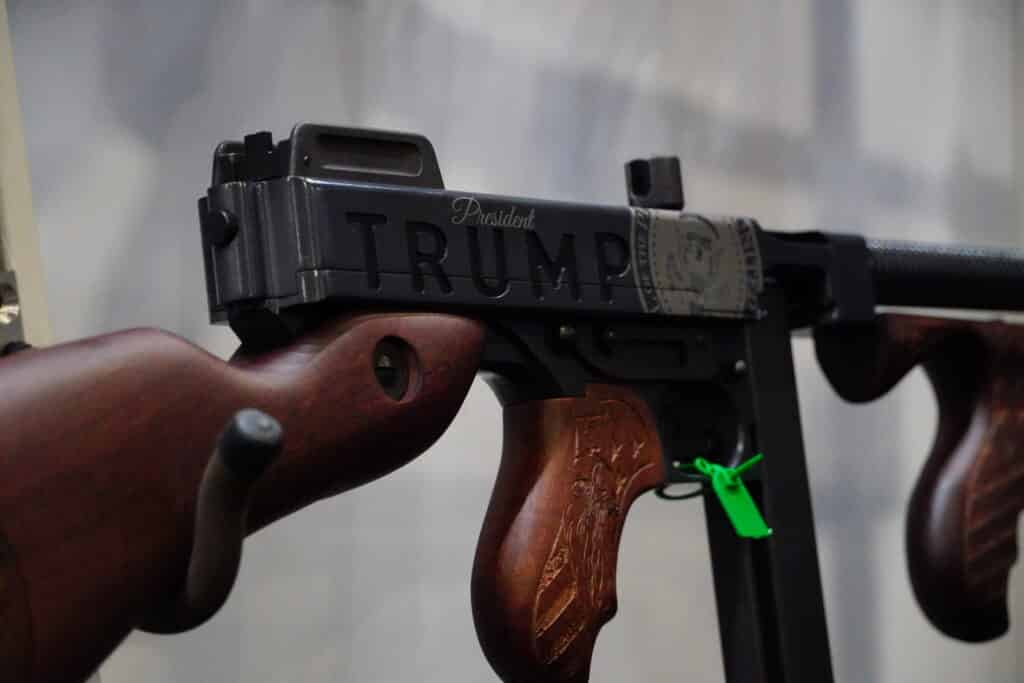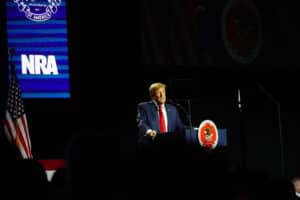We still don’t have a full picture of the outcome of the 2024 election. Things won’t be truly final for days or even longer. But we have a fairly good idea of how things are going to shake out in the broadest strokes: Republicans will control the federal government but with slim majorities.
So, what does that mean for gun policy? That’s the question I try to answer in my analysis piece. It’s also the question I brought Cam Edwards of Bearing Arms back onto the podcast to dissect.
For his part, Contributing Writer Jake Fogleman looks at the exit polling for evidence about how guns played into the vote. They seem to be in line with what polls have been saying all year: guns were a low-level issue this time around. Jake tries to explain why that might have been.
Plus, we got a preview of one of the most significant ways Donald Trump could impact gun policy in a second term: judicial appointments. A Trump appointee just ruled on the Illinois “assault weapons” ban.

Analysis: Why Were Guns Were an Afterthought in 2024? [Member Exclusive]
By Jake Fogleman
Gun voters are likely to benefit as a new Republican trifecta takes hold of the federal government in the wake of the 2024 election. Yet gun policy didn’t seem to have much to do with the outcome of the vote.
None of the major exit polls from election night mentioned the issue, either because pollsters believed it wasn’t worth asking about or because voters didn’t broach the subject.
Only the Fox News Voter Analysis survey, which differs from a traditional exit poll, featured any indication of how gun policy played a role in people’s votes. It found just four percent of the electorate rated it as their most important issue, tied for eighth among the nine issues offered.
Those results align with survey data in the months leading up to the election. Fox’s polling in February, August, September, and October consistently found gun policy as a bottom-tier issue cited by 3-4 percent of voters. Two separate September YouGov polls found the same.
So, why is that?
The first clues point to pocketbook or other social concerns drowning out gun policy. Pre-election issue polling continued to identify issues like the economy, inflation, foreign policy, and abortion at the top of voters’ minds, and the election results seem to have borne that out. Post-election exit polls have pointed to the economy and immigration dominating among Trump voters, while abortion and democracy dominated among Harris voters.
Additionally, the top-of-the-ticket candidates themselves were imperfect vessels for carrying a gun policy message. Kamala Harris launched her campaign with an aggressive gun-control platform but quickly had that muddled by her need to assuage voters over her more draconian past positions. Her closing gun message down the home stretch ended up being much more about her personal Glock ownership and willingness to shoot home intruders to appeal to moderates than policy promises.
Donald Trump ran as a defender of gun rights while being legally barred from owning a gun himself due to his felony convictions. He drew contrasts between himself and Harris on guns but didn’t emphasize the issue prominently down the stretch or make any new public policy promises. Instead, Trump primarily hectored gun owners for their, in his view, unreliability in turning out to vote. And that was after he helped steer Republicans into removing gun-rights policy promises from their 2024 platform.
Broader societal shifts also aligned in a way that reduced the salience of guns as a political issue. Based on preliminary data, murder and other violent crimes appear to have continued their historic decline this year after historic spikes in 2020 and 2021.
2024 also saw a massive drop in the number of high-profile mass shootings that tend to bring gun policy to the forefront of America’s political consciousness.
According to The Violence Project—which tracks incidents in which four or more people are shot and killed, excluding the shooter, in a public location, with no connection to underlying criminal activity, such as gangs or drugs—there have only been three such incidents this year. That’s the fewest since 2020 and the second-lowest total since 2002.
Beyond mass shootings, the most high-profile shooting incident of any kind was the first assassination attempt on Donald Trump, in which an AR-15-wielding gunman wounded him at a Pennsylvania rally. However, Trump quickly rejected any attempt to use the shooting as a push for new gun laws, and the story promptly dissipated from this year’s rapidly shifting news cycle.
None of this is to say that gun policy couldn’t have made a difference in the outcome of the race. After all, Trump won with increased support from working-class, non-college-educated voters, a demographic that tends to own guns at a higher-than-average rate and oppose stricter gun laws. Key to his victory was the outcome of seven swing states—Nevada, Arizona, Georgia, North Carolina, Pennsylvania, Michigan, and Wisconsin. Each of those states has a strong hunting and gun culture. They were all decided by low single-digit percentage points, meaning even a small number of motivated gun voters could have plausibly helped to make the difference.
It is also not to say that guns won’t matter as a policy priority post-election. The incoming Trump administration will likely appoint “pro-gun” judges and claw back some of the Biden administration’s regulatory gun-control measures. It may also pursue legislative reforms depending on the ultimate make-up and ambition of the incoming Congress, though that is less likely.
Still, it’s clear that several circumstances combined to make guns a lower-level issue in the race.

Federal Judge Rules Illinois ‘Assault Weapons’ Ban Unconstitutional
By Stephen Gutowski
The Land of Lincoln can’t ban AR-15s and other popular firearms.
That’s the ruling a federal judge handed down on Friday. Judge Stephen P. McGlynn of the Southern District of Illinois once again found the Protect Illinois Communities Act (PICA) unlawful because it bans common firearms and accessories, and the state “may not deprive law-abiding citizens of their guaranteed right to self-defense as a means of offense.” He issued a permanent injunction against the law after calling it “an unconstitutional affront to the Second Amendment” that “must be enjoined” about a year and a half after first blocking its enforcement in a preliminary hearing.
“[T]he Court holds that the provisions of PICA criminalizing the knowing possession of specific semiautomatic rifles, shotguns, magazines, and attachments are unconstitutional under the Second Amendment to the United States Constitution as applied to the states by the Fourteenth Amendment,” Judge McGlynn wrote in Barnett v. Raoul. “Therefore, the Plaintiffs’ request for a permanent injunction is GRANTED.”
He also found the state’s registration requirement for those guns ran afoul of federal gun-rights protections.
“As the prohibition of firearms is unconstitutional, so is the registration scheme for assault weapons, attachments, and large-capacity magazines,” McGlynn, a Donald Trump appointee, wrote. “Therefore, the State of Illinois is ENJOINED from enforcing the firearm registration requirements and penalties associated with entering false information on the endorsement affidavit for non-exempt weapons, magazines, and attachments previously required to be registered[.]”
The ruling is a win for gun-rights activists who’ve suffered numerous setbacks in their fight against PICA since McGlynn’s first ruling. A panel on the Seventh Circuit Court of Appeals vacated that ruling and found Illinois’s ban was likely constitutional. The Supreme Court declined to take up the case at that point and sent it back down to McGlynn for a ruling on the merits. With his new ruling siding with them on the merits, gun-rights activists can start climbing their way back up that later to the High Court once again.
Last November, the panel handed down a 2-1 decision finding semiautomatic AR-15s and the magazines that come standard with them are not “arms” under the Second Amendment because they are “indistinguishable” from their fully-automatic counterparts.
“Based on the record before us, we are not persuaded that the AR-15 is materially different from the M16,” Judge Diane Wood, a Bill Clinton appointee, wrote in Bevis v. Naperville. “Heller informs us that the latter weapon is not protected by the Second Amendment, and therefore may be regulated or banned. Because it is indistinguishable from that machinegun, the AR-15 may be treated in the same manner without offending the Second Amendment.”
Judge Wood cited the Supreme Court’s holding in DC v. Heller that certain guns fell outside the scope of the Second Amendment, including “weapons that are most useful in military service—M-16 rifles and the like.” She said AR-15s, the semiautomatic cousins of M-16s, were similar enough to be banned as well.
“We come to this conclusion because these assault weapons and high-capacity magazines are much more like machineguns and military grade weaponry than they are like the many different types of firearms that are used for individual self-defense (or so the legislature was entitled to conclude),” Wood wrote. “Indeed, the AR-15 is almost the same gun as the M16 machinegun. The only meaningful distinction, as we already have noted, is that the AR-15 has only semiautomatic capability (unless the user takes advantage of some simple modifications that essentially make it fully automatic), while the M16 operates both ways.”
In a statement attached to the Supreme Court’s notice that it had declined to take up the case, Justice Clarance Thomas attacked the panel’s decision and urged the Court to take up the case if it came back to them after a final judgment.
“This Court is rightly wary of taking cases in an interlocutory posture. But, I hope we will consider the important issues presented by these petitions after the cases reach final judgment,” he wrote. “We have never squarely addressed what types of weapons are ‘Arms’ protected by the Second Amendment.”
He called the Seventh Circuit’s decision to exclude AR-15s from the list of protected arms “contrived” and “unmoored from both text and history.” He argued, “Even on its own terms, the Seventh Circuit’s application of its definition is nonsensical.”
“It is difficult to see how the Seventh Circuit could have concluded that the most widely owned semiautomatic rifles are not ‘Arms’ protected by the Second Amendment,” Justice Thomas wrote. “[I]f the Seventh Circuit ultimately allows Illinois to ban America’s most common civilian rifle, we can—and should—review that decision once the cases reach a final judgment. The Court must not permit ‘the Seventh Circuit [to] relegat[e] the Second Amendment to a second-class right.’
Judge McGlynn ultimately tried to reconcile the Supreme Court and Seventh Circuit’s rulings on the matter.
“The AR-15 is the Rorschach test of America’s gun debate. In listening to the political debate and in reading various judicial interpretations of what the AR-15 represents, it is obvious that many are seeing very different creatures,” he wrote. “Many see one, but not the other. Our task here is to understand the duality of much of the data and the reasons for varying interpretations. Are they seeing a dragon to be slayed or a horse to pull a carriage? Often, the different perspectives are defined by whom they picture using the weapon—either a menacing criminal or a law-abiding citizen involved in a dangerous confrontation.”
He found that most of the weapons banned by PICA are protected, even under the Seventh Circuit panel’s reasoning.
“[T]he Court holds that the Plaintiffs have met their burden to demonstrate that the AR-15 and other AR-style weapons are protected ‘Arms’ within the definition advanced by the Seventh Circuit in Friedman and Bevis,” Judge McGlynn wrote. “Additionally, the Court holds that the various other ‘assault weapons’ proscribed by PICA (including AK-type weapons, various semiautomatic shotguns, and what the Government calls ‘submachineguns’) are also ‘Arms,’ as are the thirty-round large-capacity magazines and various firearm attachments designated by PICA. To reiterate, all of these weapons, magazines, and attachments are bearable, not dangerous or unusual, and are in common use. Moreover, they are all possessed for lawful self-defense purposes, are either not predominately useful for military service or are dual-use items, and are not possessed for unlawful purposes.”
He further found there was no historical tradition that would allow the government to undermine those protections and ban popular firearms.
“Sadly, there are those who seek to usher in a sort of post-Constitution era where the citizens’ individual rights are only as important as they are convenient to a ruling class,” he wrote. “Seeking ancient laws that may partner well with a present-day infringement on a right proclaimed in the Bill of Rights without reading it in conjunction with the aforementioned history is nonsense. The Statute of Northampton cannot in the least bit be used to vex the rights of Illinois citizens in the 21st century to keep and bear arms. The oft-quoted phrase that ‘no right is absolute’ does not mean that fundamental rights precariously subsist subject to the whims, caprice, or appetite of government officials or judges.”
However, he ruled .50 caliber rifles, belt-fed weapons, and grenade launchers are not protected under the same standards. Ultimate, Judge McGlynn concluded Americans should have access to whatever commonly used weapons they believed would give them the best chance of surviving a hostile encounter with somebody who meant them harm.
“When facing the possibility of armed confrontation either within one’s home or outside of it, specific weapons may confer advantages that would enable a law-abiding citizen to successfully defend oneself and one’s family from armed confrontation,” he wrote. “To limit civilians’ choice of arms would tip the scale in favor of the aggressors, who already will likely have various tactical advantages, including the element of surprise.”
Judge McGlynn issued a 30-day stay on his order, which is common in federal court rulings. That will allow Illinois to appeal his ruling back up to the Seventh Circuit if it chooses to do so.
Podcast: What Does the 2024 Election Mean for Gun Policy? (Ft. Cam Edwards) [Member Early Access]
By Stephen Gutowski
We have the topline election results, but we don’t know everything for sure yet. Many House and some Senate races have yet to be called.
Still, what we do have is enough to give us a pretty good idea of what will be possible for gun policy under the new Republican Federal trifecta led by Donald Trump. That’s why we’ve brought back Cam Edwards of Bearing Arms to help dissect what’s likely from what’s possible.
Cam said if the Republican Senate majority lands somewhere between 52 and 53, as it seems likely to, and they hold an equally slim House majority, there is little reason to think major gun bills are coming in the near future. Although, he also agreed the larger the Senate majority, the greater the odds Republicans nuke the filibuster and open up more legislative possibilities–even if he doesn’t like the idea or think it’s likely to happen.
Instead, Cam said the biggest movement on gun policy is likely to come through executive branch action. He predicted Trump would follow through on promises to undo the rules President Joe Biden has enacted, such as the pistol-brace and “ghost gun” bans. Same for firing Biden’s ATF Director.
Cam was less certain about how far Trump might go with appointing a new director or pursuing his own pro-gun rules. He argued judicial appointments are likely to be the most impactful moves Trump will make when it comes to gun policy. He said Trump may end up appointing several more Supreme Court Justices, who will serve for decades.
Then, Cam gives his view on Trump’s wild card nature and whether that could actually lead to some new gun restrictions as well. Or whether he’s given up on trying to make any kind of deal with Democrats after the past four years.
You can listen to the show on your favorite podcasting app or by clicking here. Video of the episode is available on our YouTube channel. An auto-generated transcript is here. Reload Members get access on Sunday, as always. Everyone else can listen on Monday.
A free 30-day trial of The Dispatch is available here.
Plus, Contributing writer Jake Fogleman and I break down what we know so far about the results of the 2024 election, including the likely balance of power in Congress. We cover what that might mean for gun policy and how the national gun groups influenced that outcome with their election spending. We also covered a couple of key gun-related down ballot races that broke in favor of gun-control advocates and discussed why guns likely played a marginal role this cycle.

Analysis: What Trump Could Do on Gun Policy [Member Exclusive]
By Stephen Gutowski
Donald Trump cruised to victory on Tuesday, with the rest of his party trailing behind his pace but likely gaining complete control of Congress anyway. What will the new Republican trifecta be able to pull off on gun policy?
The results of the election are still coming in. We don’t know what the Republican majorities in the Senate of House will look like for sure yet. Technically, we don’t know if Republicans will hold the House–scrap any pro-gun legislative hopes if they don’t–though it seems very likely they will since Republicans are leading in more than enough uncalled races to get at least a slim majority.
The size of those majorities may matter a lot. First off, moving anything gun-related out of the House is going to be difficult with a slim majority that currently includes a few Republicans who have backed gun-control measures in the past. Second, the Senate is unlikely to get 60 votes on any significant pro-gun legislation.
The larger the Republican majority, the greater the odds it will bypass its most moderate members and nuke the 60-vote limit set by the filibuster. Trump has supported nuking it in the past, and Republicans may be more likely to do as he wants this time around–although Mitch McConnel has already said the filibuster is still secure. If the filibuster goes away, gun-rights activists’ top priorities, like silencer deregulation and national concealed-carry reciprocity, could become law.
Even if the filibuster remains, a larger Senate majority will make it easier for Trump to quickly appoint judges. That’s the strongest part of Trump’s pro-gun record and likely to be the most consequential in his second term. He may be able to appoint several more Supreme Court justices and, even if they don’t shift the ideological balance of the Court since the oldest members are already Republican appointees, that will further cement the pro-gun majority for years to come.
The possibility of affecting some gun policy changes through legislation would also remain under the filibuster. That would come through budget bills Congress passes through the reconciliation process. The GOP could steer the direction of federal agencies that enforce gun laws, like the ATF, by pulling on their purse strings.
Of course, Trump will also have the opportunity to directly impact federal agencies that regulate guns. He may not have focused on gun policy during his campaign, but he did promise to undo everything President Joe Biden did on guns with his executive authority.
“Every single Biden attack on gun owners and manufacturers will be terminated my very first week back in office,” Trump told NRA members back in February.
That includes firing the current ATF Director, getting rid of that agency’s “zero tolerance” oversight of the gun industry, reorganizing or eliminating the White House Office of Gun Violence Prevention, and scrapping the federal rules Biden put in place. Or, at least, scrapping the ones he can since the Supreme Court appears poised to find the ATF’s “ghost gun” rule correctly interprets federal law.
Still, Trump will likely be able to unwind the pistol-brace ban, expanded regulation of used gun sales by regular people, and the latest gun export bans.
All of that would probably take time since Trump may have to go through the same lengthy federal rulemaking process that Biden used to implement those rules in order to undo them. Then there’s the possibility of using that rulemaking process to enact pro-gun rules. He hasn’t made any proposals on that front, and there are likely a lot of areas where Trump could put rulemaking to use to loosen rather than tighten gun regulations if he wants to go down that path.
Of course, last time around, his administration did the opposite with the bump stock ban (which the Supreme Court eventually struck down). The same is true of the ATF writ large. While Biden took the opportunity to appoint an ideologically aligned permanent director, even after failing the first time around, Trump stuck with career acting directors after his own party shot down his permanent nominee for a history of being too hostile to the industry.
Trump is a wild card in all of this. A lot of what happens on guns will depend on his priorities or even whims. While he made some promises early in the campaign, they mostly centered on undoing what Biden has done. Much of his campaign rhetoric on guns has focused on the threat Kamala Harris represented and how he prevented new gun control rather than promising to expand gun-rights protections, which, frankly, seems to be enough for most gun voters.
Then, there’s Trump’s tendency to consider new gun restrictions in the aftermath of major mass shootings. During his first term, he reportedly thought about supporting a ban on AR-15s and other so-called assault weapons in the wake of the El Paso shooting before being talked out of it. He publicly backed a “red flag” proposal in a meeting with lawmakers after the Parkland shooting, saying he wanted to “take the guns first” and have “due process second.”
So, while the likelihood of new pro-gun laws has certainly increased in the wake of the 2024 election, the possibility of new gun-control laws may have as well. After all, Trump would probably only need to move a small percentage of Republicans to pass any sort of gun restriction. He’s much more likely to be able to do that, if he ever wants to, than Harris would have been.
Then again, the “red flag” proposal never came to fruition because Trump’s first impeachment began before it got a chance to become a fully-fledged bill. A million things have changed since then, and it’s not clear if Trump will have any interest in working with Democrats on anything this time around.
Ultimately, it’s impossible to know exactly what the next four years will look like. But the possibilities are becoming clearer, at least.
That’s it for now.
I’ll talk to you all again soon.
Thanks,
Stephen Gutowski
Founder
The Reload








Only Members can view comments. Become a member today to join the conversation.